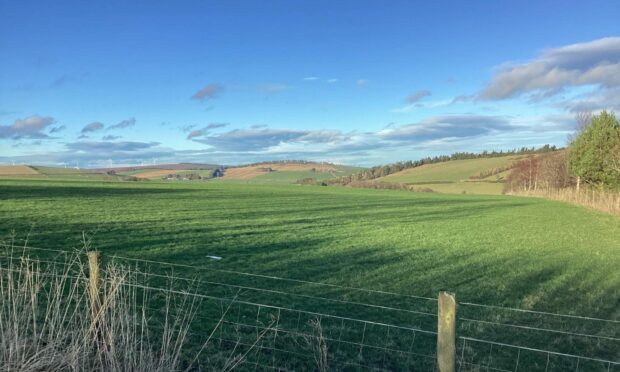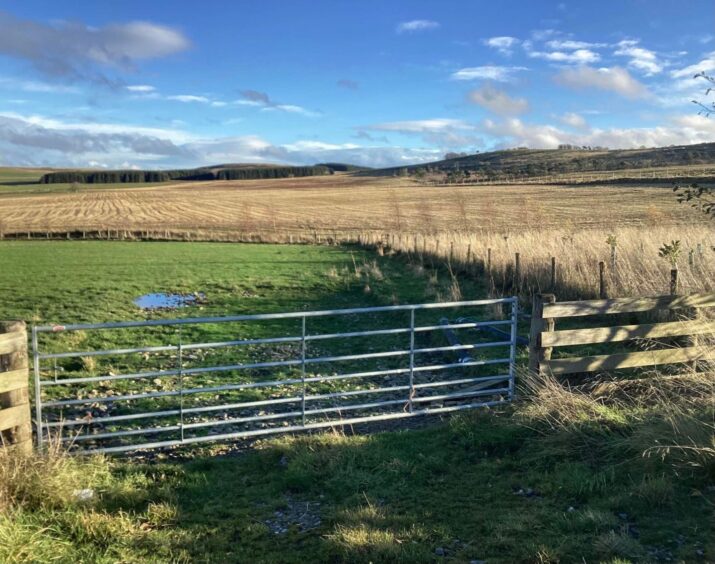A group of farmers and house owners from the Glass and Drummuir areas expressed their outrage at the potential planting of woodland on neighbouring farmland which was recently sold to a global investment company.
More than 30 locals gathered at the village hall this week to attend a meeting which was supposed to include representatives from Foresight Sustainable Forestry – the buyers of the land who hope to begin the planting of trees by the end of this year.
The investment company purchased 420 acres at Mains of Blairmore near Huntly and Keith, last year and are currently going through the application process to use 348 acres of this for the Burn of Bellyhack woodland creation.
Almost 270 acres of this will be planted with commercial trees of species spruce, while 42 acres will be used for non-commercial native broadleaves such as silver birch. Just under eight acres will be planted with mainly productive broadleaf birch trees.
Those who attended the meeting were disappointed to find that representatives from the company had failed to turn up and were left to raise their concerns with two employees from EJD Forestry, which is the agent for Foresight Sustainable Forestry.
Almost 350 acres of agricultural land will be planted in trees
One member of the group, which included NFUS vice-president Andrew Connon, highlighted that they weren’t totally in disagreement with tree planting but said they were completely against the planting of trees on productive farmland, especially on such a largescale.
Many of the locals were keen to know why a large block of land which previously reared livestock and grew malting barley had been purchased for commercial timber production as appose to using other poorer performing ground in the area.
Gary Christie, who farms close to Mains of Blairmore, described the tree planting across Scotland’s farmland as a ”modern day Highland Clearances” and said it was a huge risk to food security and production.
He said it was some of the best land in the area and they had picked the wrong place to plant on.
Mr Christie’s son and another young farmer in the group said it was another example of future generations and new entrants being pushed out by big investor companies who were outbidding those keen to expand to produce food for the nation.
The spokesperson from EJD Forestry said that they were following government policy and contributing to the proposal of planting 12,o00 hectares of trees per year, to which one member of the group replied: “You can’t eat a tree.”
Locals were also shocked to hear that not one member of Foresight Group had stepped foot on the land to see the type of land they had invested in and what detrimental effects it would have on the rural community.
“The investors have no interest in the people or rural communities,” said one farmer’s wife.
“It’s heart wrenching to think we have built up a business and now all we are going to be left with is a view of the sky and a plane going by.
“We are leaving a legacy behind that’s going to be hugely affected by this. All they are interested in is money and carbon footprints, and they are not sensitive at all.”
Others raised concerns about their homes depreciating in value and argued whether the water table would be fit to support such a large area of woodland.
‘The investors have no interest in the people or rural communities’
John Findlay, who farms at Turfhillock, said it was ”completely outrageous” to ruin such good farmland and another local asked whether there was a management plan in place for controlling wildlife and vermin such as deer and foxes.
Robert Guest, who is co-head of Foresight Sustainable Forestry, claimed they were working in line with all of its afforestation schemes.
He said the plans had been sensitively designed to incorporate a diverse mix of tree species, to include open spaces for natural habitat and to make a positive impact in terms of both climate change mitigation and increased biodiversity.
“Foresight always engages closely with the local community at all our sites, including showing them our forests designs, and Wednesday’s meeting was very much part of that approach,” said Mr Guest.
“We were represented by qualified forestry professionals who work closely with our Edinburgh-based team and who have a detailed knowledge of the scheme and we look forward to continued, regular engagement throughout this process.”
‘Foresight always engages closely with the local community’ says co-head of company
“Foresight is supportive of the government policy which we believe takes a balanced approach to the potential uses for such land. We believe that the government targets recognise the country’s need to increase its supply of sustainable timber and reduce its carbon footprint alongside the continuation of traditional farming.”
Mr Guest said that the land due to be planted at Burn of Bellyhack is categorised by Scottish Forestry as ‘preferred or potential for planting’.
Despite locals proving that the land is more than fit for agricultural purpose, Mr Guest claims that it will not support commercially viable arable cropping but does enable a well-designed commercial forest to produce good yields of sawlog from a wide range of species.
The government planting targets in Scotland will increase from 15,000 hectares each year from March 2024 until 2030 which equates to 119,000 hectares in total.
This represents 4% of the aggregate of all grade 3.2, grade 4 and grade 5 land in Scotland where the vast majority of commercially viable planting will take place.
Government policy is to plant 15,000 hectares of trees each year from 2024 until 2030
Andrew Connon argued that under 7% of Scotland’s farmland was classified as ‘prime’ land (grade 1 to grade 3.1) and said that the government had to get a better understanding on the productivity of the classified grades.
A second meeting is due to be arranged with Foresight Sustainable Forestry and the locals hope to be supported by local MSPs.

